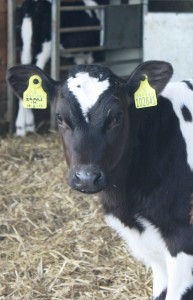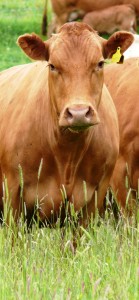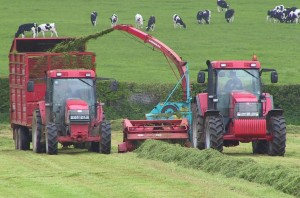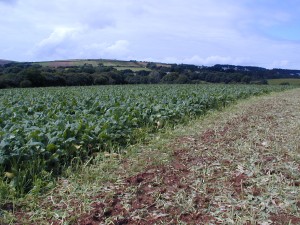Cattle Diseases
Selenium Deficiency in Cattle
Also known as: Muscular Dystrophy, Myopathy, Nutritional Myodegeneration, White Muscle Disease
Selenium and Vitamin E have complementary but independent roles as antioxidants and are essential elements for animals. A number of antioxidants and trace minerals have important roles in immune function and may affect health in transition dairy cow (Spears and Weiss, 2008) as well as muscle growth and function in calves. The requirements depend on age, physiological stage and species (Villar et al., 2002). Vitamin E is synthesized by plants but not by animals. Grass normally contains adequate levels of vitamin E, but lush spring grass may contain high levels of polyunsaturated fatty acids (PUFAs). When eaten by the animal, these PUFAs are highly susceptible to oxidation. Forage crops such as rape or kale are a good source of vitamin E, as is grass silage. Root crops are poor sources and many hays may also be low in vitamin E. The maturity and storage of feed materials affect their vitamin E content. Cereals contain moderate levels of vitamin E, but the use of propionic acid or caustic soda to preserve moist grain rapidly destroys the vitamin.
Selenium and Vitamin E Deficiency Distribution
Selenium status in grazing crops is dependent on incorporation from soil, which in turn obtains most of its selenium from surrounding rocks. However, substantial areas of the much of the northeastern and northwestern US and adjacent Canada, the southeastern US and in the United Kingdom, especially north-east Scotland and parts of south-east England, are selenium deficient (Anderson et al., 1979; Arthur et al., 1979). Selenium level in herbage is influenced by other constituents of the soil, as well as by the chemicals applied to it (Murphy and Quirke, 1997). In some regions, it has been suggested that selenium status may be poorer in pasture based organic systems in Norway compared to conventional farming systems (Govasmark et al., 2005), although this was not associated with higher prevalence of clinical disease associated with selenium deficiency on the organic farms. The lower status may be due to reduced use of selenium containing fertilizers.
Clinical Signs of Selenium and Vitamin E Deficiency
Selenium Deficiency in Calves
 Subacute muscular dystrophy, also known as white muscle disease, is the most commonly seen form of selenium deficiency in calves. Between 10% to 40% of animals die of this condition (Andrews A. H., 1992). The signs depend on the muscles affected. The calf may stand and move stiffly. It is weak and reluctant to move. However, the calf is fully conscious and has a normal appetite, temperature and respiratory rate, though the heart rate may be raised. In some cases, the affected muscles are swollen and firm on palpation (Andrews and Blowey, 1992; Suttle et al., 1992).
Subacute muscular dystrophy, also known as white muscle disease, is the most commonly seen form of selenium deficiency in calves. Between 10% to 40% of animals die of this condition (Andrews A. H., 1992). The signs depend on the muscles affected. The calf may stand and move stiffly. It is weak and reluctant to move. However, the calf is fully conscious and has a normal appetite, temperature and respiratory rate, though the heart rate may be raised. In some cases, the affected muscles are swollen and firm on palpation (Andrews and Blowey, 1992; Suttle et al., 1992).
In acute muscular dystrophy, the calf becomes dull and lies in lateral recumbency. It often occurs in spring when calves are turned out to graze. There is respiratory distress and heart rate is elevated, but the temperature is normal. The calf is fully conscious. Most cases die within 6-18 hours. Adverse weather conditions, exercise and stress may all predispose the calves to acute myopathy (Suttle et al., 1992).
Other signs of selenium deficiency in calves:
- Growth retardation before and after weaning
- May develop Heinz-body anemia (Morris et al., 1984).
- Increased susceptibility to infectious diseases (Nockels, 1996)
- Potential to develop chronic skeletal and weakening of the heart muscles (cardiac myopathy) if the dam is deficient.This may be the case in winter when the dam is eating conserved forages.
- In the case of sudden death syndrome, a perfectly healthy-looking calf may suddenly collapse during or shortly after feeding. Death is usually within a minute of collapse.
Diagnosis of vitamin E deficiency in acute cases of myopathy in calves should be straightforward, based on the history of recent turnout or additional exercise, combined with a high intake of lush grass or a farm history of low vitamin E or selenium. On post-mortem, characteristic signs of white streaking in the muscles are seen, caused by fibrosis following muscle damage.
Selenium Deficiency in Adult Cattle
 Clinical signs of low selenium/vitamin E status in adult cows are more difficult to determine. However, adult cows with a selenium/vitamin E deficiency may be more likely to retain the placenta, have an abnormal calving and are more susceptible to metritis and cystic ovaries (Erskine et al., 1997; Harrison et al., 1984; Kommisrud et al., 2005; LeBlanc et al., 2004; Mee, 2004). Selenium deficiency has also been linked with milk fever (Heilig et al., 2014).
Clinical signs of low selenium/vitamin E status in adult cows are more difficult to determine. However, adult cows with a selenium/vitamin E deficiency may be more likely to retain the placenta, have an abnormal calving and are more susceptible to metritis and cystic ovaries (Erskine et al., 1997; Harrison et al., 1984; Kommisrud et al., 2005; LeBlanc et al., 2004; Mee, 2004). Selenium deficiency has also been linked with milk fever (Heilig et al., 2014).
Vitamin E deficiency has also been shown to:
- Precede left displaced abomasum in early lactation dairy cows (Qu et al., 2013)
- Increase the risk of infertility (Aréchiga et al., 1998)
- Increase the risk of mastitis (Allison and Laven, 2000; Ndiweni et al., 1991; Smith et al., 1997; Ali-Vehmas et al., 1997; Weiss et al., 1997)
- Increase subclinical mastitis assessed by somatic cell counts (Baldi et al., 2000).
It has been reported that white cell function from cows with higher blood selenium concentrations have a better killing ability and therefore may be better able to resist disease (Cebra et al., 2003; Nockels, 1996). Despite evidence supporting a beneficial effect on cow health with additional selenium/vitamin E supplementation, there are a number of studies suggesting no effect with supplementation (ADAS, 2004; LeBlanc et al., 2002; Sivertsen et al., 2005). Effects are likely to be farm specific and depend largely on the existing trace element status of the herd.
Determining the actual optimum selenium/vitamin E content of the diet is very difficult. The current practice of linking requirement of adult cows to dry matter intake may not be ideal as the requirement is most likely to be highest when the feed intake is lowest, such as at the peri-parturient period (Allison and Laven, 2000). In cows fed stored forages, relatively high supplemental levels of vitamin E (3000–4000 IU/day) are needed to prevent the drop in plasma-tocopherol concentrations around parturition. However, for cows with existing adequate intakes, increasing vitamin E intake above the current recommended levels is not associated with a reduction in disease incidence (Bourne et al., 2003).
Diagnosis of selenium deficiency in adult cattle can be more difficult to definitively make, although blood sampling and analysis of blood glutathione peroxidase (GHPX) can help determine selenium status. This reflects selenium intake around 6 weeks prior to sampling, as GHPX is an antioxidant enzyme associated with red blood cells which are formed several weeks prior to release into circulation.
Vitamin E and Selenium Deficiency Control and Prevention

- Silage making, if done well, retains more of the vitamin E than many methods of forage preservation.
Animal Feeds and Selenium Deficiency
The inclusion of feedstuffs rich in vitamin E occurs indirectly, as pasture based farming principles promote the inclusion of forage crops such as legumes in the ration. These are relatively rich in vitamin E. However, problems can occur when root crops are grown as part of the crop rotation. These root crops are low in vitamin E and need to be fed in conjunction with feedstuffs rich in vitamin E. Green forages are generally good sources of vitamin E although concentrations can vary considerably between farms and different years. There may be a poor correlation between soil status and forage trace element status on some organic farms potentially related to the absence of selenium supplied by fertilizers (Govasmark, 2005). Additionally, the time of year has a strong effect on the availability of dietary vitamin E, with higher concentrations in fresh grazed grass (in the summer) compared to preserved forages (in the winter). Silage making, if done well, retains more of the vitamin E than many methods of forage preservation, although mown forages that are left exposed to sunlight to wilt prior to ensiling will lose some vitamin E.
Pasture based farms have been reported to have a relatively low vitamin E content in the ration, although there may not be clinical signs of the condition (Knudsen et al., 2001), therefore it is important to incorporate selenium and vitamin E rich feedstuff into the ration.
There is currently much interest in methods to improve meat quality by dietary manipulation. A pasture based diet should contribute sufficient anti-oxidants by means of vitamin E to prevent lipid oxidation in muscle and subsequently any meat produced (Descalzo et al., 2005). However, it should be remembered that lush spring grass may contain high levels of polyunsaturated fatty acids (PUFAs). When eaten by the animal, these PUFAs are readily oxidized requiring higher concentrations of anti-oxidants to prevent damage caused by the associated free radical formation.
The selenium levels in herbage are not only determined by the level of selenium in the soil but also by the chemicals that are applied to it. For example, the application of superphosphate fertilizers containing sulfates may reduce the uptake of selenium from the soil by plants, or may reduce its availability to the animal, or a combination of both. Also, preservation of grass silage with sulfuric acid may interfere with the availability of selenium.
Supplements
Assessing the needs of cattle for trace element supplements are difficult. Any decisions must be made on the basis of the evidence shown by the animals that needs are not being met (Van Metre and Callan, 2001; Suttle, 2004). Growing calves should receive a supplement at a rate of 0.1 p.p.m. selenium of the total ration and 150 mg/head/day of a-tocopherol to ensure adequate status of both nutrients (Andrews et al., 1992).

Licks and free choice minerals are possible, but are not ideal because of variable intakes. Therefore, a slow release bolus would be the most acceptable and practical method of supplementation in pasture based farming.
There are several methods of supplying vitamin E and /or selenium (Culleton et al., 1997; MacPherson, 1983). They include: injections, supplementation of concentrate feeds, additions to rations of feedstuffs rich in selenium (Bruce et al., 1998) and vitamin E (Suttle, 1992), selenium supplementation in salt licks/ free access minerals, supplementation of the drinking water, oral administration of selenium/vitamin E slow-release pellets/boluses (Hemingway, 2003), periodic oral drenching with selenium salts and application of selenium salts directly to soils. This method is infrequently used because the response varies from farm to farm and because of the risk of poisoning. An increase in body temperature in calves has been reported following vitamin E injections (Batra et al., 1995). The use of in-feed minerals or supplementation of the drinking water also contains a risk of poisoning. Licks and free choice minerals are possible, but are not ideal because of variable intakes. Therefore, a slow release bolus would be the most acceptable and practical method in pasture based farming.
Cows with calves at foot or in late pregnancy can be supplemented with vitamin E and/or selenium to supplement their calves, especially those calving in late winter (Bass et al., 2001), although it must be remembered that optimum vitamin E intake by the calf depends on both transfer in-utero (which is limited) and importantly, intake of sufficient colostrums as the fat soluble vitamins concentrate in milk (Enjalbert et al., 1999; Lacetera et al., 1996; Quigley and Drewry, 1998. Combined vitamin E/selenium injections or slow release selenium/vitamin E boluses (Allan et al., 1993) are useful methods of supplementation.
It has also been suggested, although not conclusively proven, that fertility of cows may be improved when given multi-trace element boluses in both dairy (Black and French, 2004) and more conclusively in beef herds (Hemingway, 2003). If necessary, older ruminating calves (above 75 kg body weight) can be given a bolus to prevent chronic selenium/vitamin E deficiency causing poor growth rates (Hemingway et al., 1996). Again, the risk of selenium toxicity has to be taken into account.
Treating Selenium Deficiency
Calves with sudden death syndrome or acute muscular dystrophy are usually found dead. Commercial injectable vitamin E/selenium preparations to treat subacute muscle dystrophy are available. In severe cases, injections may have to be repeated weekly for several weeks, and in such cases the risks of toxicity with Selenium rich preparations should be considered.
Good Practice Based on Current Knowledge
- Establish whether the soil and farm grown forages are deficient in selenium
- Establish whether selenium/vitamin E deficiency may be a reason why stock are not doing well (consider blood sampling or post mortem examination where appropriate)
- Use plants in the sward (e.g. legumes) containing a higher level of minerals, including selenium
- Combine feedstuffs low in vitamin E (e.g. root crops or hay) with high ones (e.g. grass silage or forage crops)
- Do not use any preservatives which destroy vitamin E (e.g. sulfuric acid in grass silage)
- Use slower growing breeds of cattle
- Control and prevent selenium/vitamin E deficiency where there is proven to be a farm deficiency problem in calves by giving pregnant cows a selenium/vitamin E containing bolus or injection
- If necessary, prevent chronic selenium/vitamin E deficiency causing poor growth rates in older ruminating calves (above 75 kg body weight) with a selenium/vitamin E bolus.
- Use injectable vitamin E/selenium preparations to treat calves with subacute muscle dystrophy
- Do not over-supplement with selenium, to prevent risks of selenium poisoning
- On severely selenium/vitamin E deficient farms, a strategy should be worked out with the veterinarian to control and prevent deficiency in cattle as part of the health plan. (For example, using management strategies, combining feedstuffs low and high in vitamin E, strategic use of boluses, in-feed minerals, mineral licks)
- Measures should be taken to improve the situation in the long term and to reduce dependency on conventional treatments. For example, the composition of the sward could be changed in such a way that the mineral status is improved (e.g. inclusion of legumes) and slower growing breeds of cattle could be used


 British English
British English


Comments are closed.